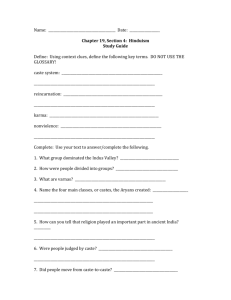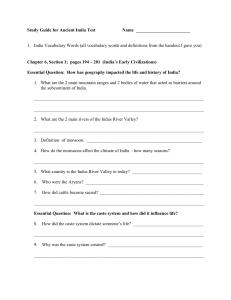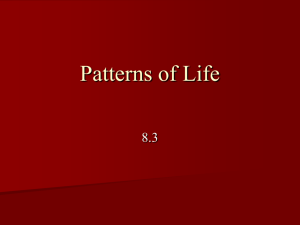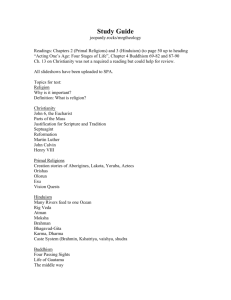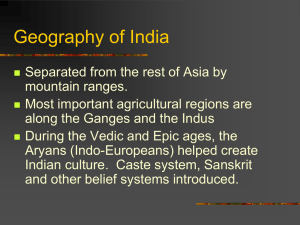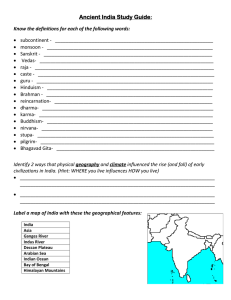Early India & Hinduism Notes
advertisement
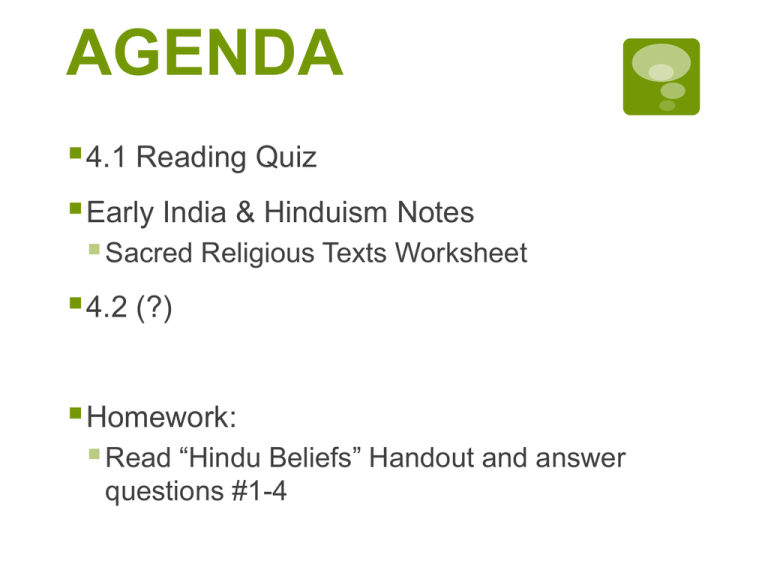
AGENDA 4.1 Reading Quiz Early India & Hinduism Notes Sacred Religious Texts Worksheet 4.2 (?) Homework: Read “Hindu Beliefs” Handout and answer questions #1-4 Early India September 2015 Main Ideas Early civilization arose in the Indus River Valley, flourished, and then died out The Indus River Valley civilization thrived from 2500 BCE – 2000 BCE Later, India’s Vedic civilization developed a culture based on old and new beliefs. Note! BCE Before Common Era Like “BC” CE Common Era Like “AD” Snapshot of India India is a country in South Asia 2nd largest population in the world Capital: New Delhi Languages: Hindi & English Religions: Hinduism, Islam, Christianity Hinduism = 80% of population Geography Subcontinent Large landmass that juts out from a larger continent 3 Geographical Zones Mountains Hindu Kush & Himalayas Deccan Plateau Dry Northern Plains Fertile soil Monsoons Heavy winds and heavy rains Both helped and hurt early peoples Indus Valley Civilizations First civilization along Indus River Guessed to be about 2500 BCE Remains show complex cities and villages Well planned and designed Suggests a functioning government Economy focused on agriculture and trade Traded both locally and great distances Little is known about Indian culture and civilization Believed to be a single society vs. many states Decline… Thrived from about 2500 BCE – 2000 BCE Best guesses for decline… Floods Famine Over-farming Other natural causes Aryans moved into the Indus Valley around 1500 BCE – not sure if they caused the collapse or if they followed it Aryans A group of Indo-Europeans that migrated into the Indus River Valley from the Caucasus Mountain Region Aryan = Sanskrit world meaning noble Little known about them Sacred literature, the Vedas is all the archeologists have on them Hence the name “Vedic Period” Vedic Period Society: Smaller villages than IRV civilization Some villages grouped together under regional leaders known as rajas Rajas were also war leaders Society was divided into four varnas (caste system) Caste System Divided into 3 classes or castes: Priests (Brahmins) – highest ranking, fewest in number Warriors (Kshatriyas) Peasants (Vaisyas) Non Aryans made up a fourth class (Sudras) Caste System People treated according to position in caste system Born into caste for life People outside caste system = “untouchables” Gravediggers, butchers, trash collectors Considered “impure” Hinduism Hinduism – Quick Facts 80% of the population in India practice Hinduism World’s 3rd largest religion Called “one of the oldest living religions” No single founder Where did Hinduism come from? Named after the people on the southern side of the Sindu (Indus) River, as described in the Vedas, an ancient text Ultimately spread through out the subcontinent, absorbing cultural and religious practices, but continuing to claim the Vedic tradition Hindu Scriptures Vedas: hymns of praise dating from second millennium BCE; contain information gods, riturals, varnas (castes), duties of priests Upanishads: reflections on the Vedas Epics: Ramayana and Mahabharata Bhagavad-Gita is a 700 verse scripture that is part of the Mahabharata Hindu Scriptures Using the textbook, fill in the scriptures chart Explain what each scripture is how it is important to Hinduism God - Brahman The Universal Soul or Supreme power To access and understand the workings of God in the world, people worship and pray to other manifestations of God God is also trinity of Brahma – creator Shiva – destroyer Vishnu – preserver Beliefs Dharma Karma Samsara Moksha Dharma “Law of being” Principle or law that orders the universe Individual conduct in conformity with this principle Sacred duty Both spiritual and practical Dictated by Caste Age Station in life (single, married, parent, child) Karma All deeds (even small ones) have an effect (negative or positive) The state of one’s soul (atman) Cumulative impact of one’s actions Your actions now impact your next life Samsara The continuing cycle of the soul’s birth, death, and rebirth Reincarnation: the rebirth into another living form Whether one achieves rebirth into a higher or lower station is result of karma Moksha The release from samsara (release from the cycle of rebirth) Reaching moksha is THE goal of spiritual Hindus The merging of the individual soul (atman) with the Universal Soul (Brahman) In Short… The way to achieve moksha is to fill one’s dharma (duties) Fulfilling one’s dharma allows a person to create good karma
